The digestive tract (also known as the alimentary canal) is the system of organs within multicellular animals that takes in food, digests it to extract energy and nutrients, and expels the remaining waste. The major function of the GI tract are ingestion, digestion, absorption, and defecation. The GI tract differs substantially from animal to animal. Some animals have multi-chambered stomachs, while some animals' stomachs contain a single chamber. In a normal human adult male, the GI tract is approximately 6.5 meters (20 feet) long and consists of the upper and lower GI tracts. The tract may also be divided into foregut, midgut, and hindgut, reflecting the embryological origin of each segment of the tract.[1]
viernes, 29 de mayo de 2009
viernes, 22 de mayo de 2009
Resum del sistema nerviós
The nervous system is divided into the central nervous system and peripheral nervous system.
 Central Nervous System
Central Nervous System 
The central nervous system is divided into two parts: the brain and the spinal cord. The brain contains about 100 billion nerve cells (neurons) and trillons of "support cells" called glia.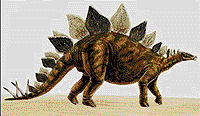 A stegosaurus dinosaur weighed approximately 1,600 kg but had a brain that weighed only approximately 70 grams (0.07 kg). Therefore, the brain was only 0.004% of its total body weight. In contrast, an adult human weighs approximately 70 kg and has a brain that weighs approximately 1.4 kg. Therefore, the human brain is about 2% of the total body weight. This makes the brain to body ratio of the human 500 times greater than that of the stegosaurus. See "My Brain is Bigger than Your Brain" for more about brain size. A stegosaurus dinosaur weighed approximately 1,600 kg but had a brain that weighed only approximately 70 grams (0.07 kg). Therefore, the brain was only 0.004% of its total body weight. In contrast, an adult human weighs approximately 70 kg and has a brain that weighs approximately 1.4 kg. Therefore, the human brain is about 2% of the total body weight. This makes the brain to body ratio of the human 500 times greater than that of the stegosaurus. See "My Brain is Bigger than Your Brain" for more about brain size. |
Peripheral Nervous System
The peripheral nervous system is divided into two major parts: the somatic nervous system and the autonomic nervous system.
Somatic Nervous System
![[somatic nervous system]](http://faculty.washington.edu/chudler/gif/somns.gif) The somatic nervous system consists of peripheral nerve fibers that send sensory information to the central nervous system AND motor nerve fibers that project to skeletal muscle.
The somatic nervous system consists of peripheral nerve fibers that send sensory information to the central nervous system AND motor nerve fibers that project to skeletal muscle.
Autonomic Nervous System
 The autonomic nervous system is divided into three parts: the sympathetic nervous system, the parasympathetic nervous system and the enteric nervous system. The autonomic nervous system controls smooth muscle of the viscera (internal organs) and glands.
The autonomic nervous system is divided into three parts: the sympathetic nervous system, the parasympathetic nervous system and the enteric nervous system. The autonomic nervous system controls smooth muscle of the viscera (internal organs) and glands.
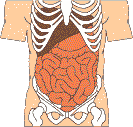
The enteric nervous system is a third division of the autonomic nervous system that you do not hear much about. The enteric nervous system is a meshwork of nerve fibers that innervate the viscera (gastrointestinal tract, pancreas, gall bladder).

| Divisions of the Nervous System | |||
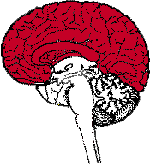 Telencephalon Telencephalon | 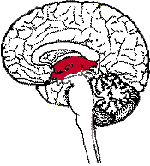 Diencephalon Diencephalon | 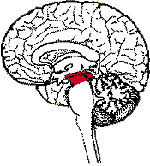 Mesencephalon Mesencephalon | |
 Metencephalon Metencephalon | 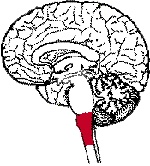 Myelencephalon Myelencephalon |  |
From a top view, notice how the brain is divided into two halves, called hemispheres. Each hemisphere communicates with the other through the corpus callosum, a bundle of nerve fibers. (Another smaller fiber bundle that connects the two hemispheres is called the anterior commissure). 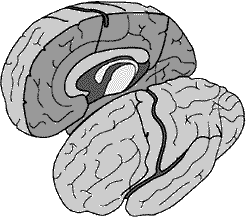
Some differences between the peripheral nervous system (PNS) and the central nervous system (CNS):
- In the CNS, collections of neurons are called nuclei. In the PNS, collections of neurons are called ganglia.
- In the CNS, collections of axons are called tracts. In the PNS, collections of axons are called nerves.
In the peripheral nervous system, neurons can be functionally divided in three ways:
- Sensory (afferent) - carry information INTO the central nervous system from sense organs or motor (efferent) - carry information away from the central nervous system (for muscle control).
- Cranial - connects the brain with the periphery or spinal - connects the spinal cord with the periphery.
- Somatic - connects the skin or muscle with the central nervous system or visceral - connects the internal organs with the central nervous system.
Brain Structures
Cerebral Cortex:The word "cortex" comes from the Latin word for "bark" (of a tree).
Cerebellum:
The word "cerebellum" comes from the Latin word for "little brain.
Brain stem:
The brain stem is a general term for the area of the brain between the thalamus and spinal cord.
Hypothalamus:
The hypothalamus is composed of several different areas and is located at the base of the brain.
Thalamus:
The thalamus receives sensory information and relays this information to the cerebral cortex.
Limbic System:
The limbic system (or the limbic areas) is a group of structures that includes the amygdala, the hippocampus, mammillary bodies and cingulate gyrus.
Hippocampus:
The hippocampus is one part of the limbic system that is important for memory and learning.
Basal Ganglia:
The basal ganglia are a group of structures, including the globus pallidus, caudate nucleus, subthalamic nucleus, putamen and substantia nigra, that are important in coordinating movement.
Midbrain:
The midbrain includes structures such as the superior and inferior colliculi and red nucleus. There are several other areas also in the midbrain.
